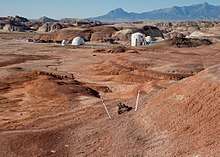University Rover Challenge

The University Rover Challenge (URC) by the Mars Society is a robotics competition for university level students that challenges teams to design and build a rover that would be of use to early explorers on Mars.[1] The competition is held annually at the Mars Desert Research Station, outside Hanksville, Utah in the United States. The site was selected by the Mars Society for its geographic similarity to Mars: In addition to being a largely barren desert area, the soil in the area has a chemical composition similar to Martian soil. The competition has also expanded internationally to include the European Rover Challenge, Canadian International Rover Challenge, and the Indian Rover Challenge as part of the Rover Challenge Series.

The aim of the University Rover Challenge is to encourage students to develop skills in robotics, improve the state-of-the-art in rovers, and work in multi-disciplinary teams with collaboration between scientists and engineers. The competition was launched in 2006 with competitions held annually every summer since 2007.
Tasks
Specific scenario details change each year as teams master given tasks and to encourage flexibility in designs and improve the capabilities of the rovers each year. Rovers are required to perform tele-operated or autonomous tasks that would assist astronauts in the field. Tele-operated tasks are performed from control stations with no direct view of the rover, only what can be determined via video and data links from the rover or sensors deployed by the rover. It is assumed the operators are also on Mars so there is no time-delay in communications. For 2017 tasks included:

Science Mission
Rovers search for evidence of potential for a site to support life. Rovers must take sub-surface soil samples and analyze them for the likelihood to support microbial life including the geological context such as evidence of water flow. The rover must then store samples in a cache and at a later time in a laboratory team scientists may conduct additional experiments on the returned samples.[2] The aim of this task is to encourage cooperation between scientists and engineers working in a team to design and build the rover to achieve scientific objectives, and to encourage the study of Martian science.

Delivery Mission
Rovers must collect a variety of objects from the field and deliver them to astronauts across a wide variety of terrains of increasing difficulty, including soft sandy areas, boulder fields, and steep hills.[2] The aim of this task is to encourage rugged and capable rovers that can handle a wide variety of natural terrains.
Equipment Servicing Mission
Rovers must perform several dexterous operations on a mock-up equipment system. 2017 required rovers to tow a wagon carrying a fuel canister to a generator, fill up the fuel tank, swap the regulator on gas cylinders, and start the generator by pressing a button.[2] Previous equipment tasks have included pumping air into an inflatable habitat, and cleaning solar panels. The aim of this task is to encourage design of highly dexterous robot arms and systems that can perform tasks that a human can easily accomplish but that are currently often difficult for robots.

Autonomous Travel Mission
Rovers must autonomously travel between markers across increasingly difficult terrain, requiring increasingly sophisticated sensing of the environment and route planning.[2] The aim of this task is to encourage increased levels of autonomy in robotic systems relieving load on astronauts to perform other tasks such as not having to tele-operatedly drive a rover from one location to another.
Presentation
Teams must submit a written report and a short video describing and demonstrating the design and capabilities of the rover to perform the required tasks, scientific plan, and team management.

See also
References
- ↑ "University Rover Challenge". marssociety.org. Retrieved Aug 18, 2017.
- 1 2 3 4 "Rules Released for 2017 University Rover Challenge - University Rover Challenge". urc.marssociety.org. Retrieved 2018-09-28.
External links
| Wikimedia Commons has media related to University Rover Challenge. |